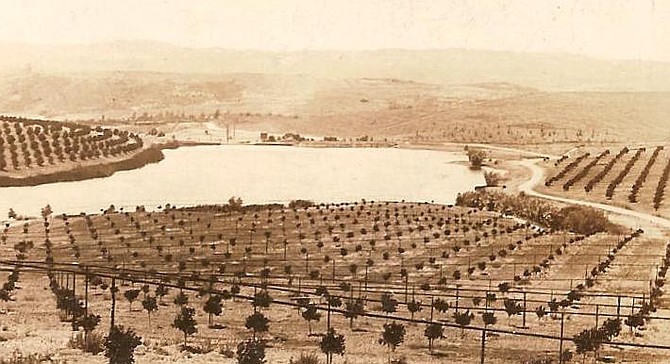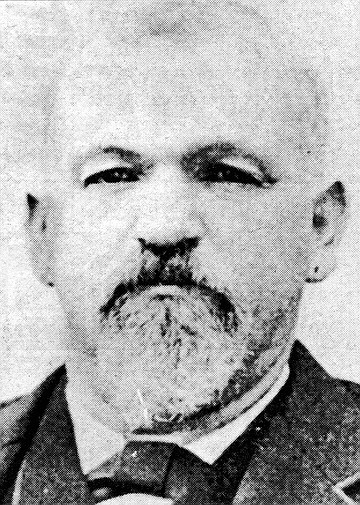 Facebook
Facebook
 X
X
 Instagram
Instagram
 TikTok
TikTok
 Youtube
Youtube

The first Italian to set foot in San Diego must not have thought too much of the place. In April 1827, the French Ship Heros sailed into San Diego Bay. Paolo Botta, the ship’s doctor, came ashore by with a landing party but “failed to recognize this singular honor, for while he wrote an account of the Indians and wild life of California, he left no record of his impressions of San Diego.” (Auguste Duhaut-Cilly, the ship’s captain, did. He wrote that the Presidio was “sad, bleak, and dingy,” and the Mission a veritable “sink of dirt and deterioration.”)

Marco Bruschi and Pietro Lusardi were the first Italian pioneers of significance in San Diego (Lusardi came in 1866; Bruschi in 1869). Bruschi was born in Parma, Italy, in 1840. His brother, Francesco, had a store in Coulterville, in Mariposa County, since 1850. Gold brought Bruschi and thousands of others, overland and around the hom, to California. In 1864, Bruschi joined with his childhood friend, Pietro Lusardi, also from Parma, and they became partners in a mining business near Coulterville.
Although they enjoyed “some success,” Bruschi’s gold fever cooled. He heard that G. Ginocchio’s large grocery firm, in San Francisco, planned to set up a store in San Diego. Bruschi became a partner in the firm and moved to San Diego in 1869.
The Ginocchio Company didn’t open the store until 1876, but Bruschi kept busy in the interim. He ran a saloon. He also hired ragpickers, who pick up rags and other waste materials from the streets and refuse heaps. In one shipment to San Francisco, Bruschi sent more than two tons of white and colored bales of rags.
In 1872, Bruschi fitted out two schooners, the Lark and Dolphin, to go seal hunting at the Cedros and San Benito Islands, off Baja’s central coast. “The Lark returned with 270 skins and 30 barrels of seal oil, while the Dolphin brought in 204 skins. Bruschi sent the pelts to New York, where he received $7.50 a skin, a handsome profit according to the San Diego Union. ”
Bruschi made numerous investments: mines in Baja California (he went back to Italy, in 1882, to secure funding for the enterprise), a ranch in Otay Mesa, and an interest in the Hotel L’Europe on Fifth Avenue and H Street. When the Ginocchio Company opened its store, in 1876, Bruschi managed it for many years. He also opened his own, the Mariposa Grocery Store, on the corner of Fifth and Market — “the name reminiscent of his gold-mining days of so many years before.” Bruschi was “immensely popular” in San Diego and Baja. That his grocery business had “the lion’s share of American trade as far south as Ensenada probably depended as much on that mutual affection as on his business ability.”
He also gained local fame for a mismatched footrace. In 1879, the San Diego Union reports that, for a five-dollar bet, “our corpulent friend Marco Bruschi” ran a 50-yard race against a “Mr. Tobias,” whose size and athletic prowess go unmentioned, though the newspaper makes him sound like the “hare” to Bruschi’s “tortoise.”
Tobias led most of the race. Then, “during the last 20 feet, Tobias fell and Bruschi huffed across the finish line in triumph.” The Union reported that “victory does not always belong to the swift” When Bruschi died, in 1915, “thousands of people — both Mexican and American — mourned the loss of the genial, generous pioneer.”
Pietro Lusardi, Bruschi’s friend and mining partner in the gold fields, came to San Diego with his brother, Francesco. They ran sheep on Mt. Palomar, then built a 3000-acre sheep ranch in the Black Mountain area of Rancho Santa Fe (in an interview, Henry Lusardi, Francesco’s son, stated that “his father and Uncle Pietro accumulated a good portion of their ranch by having their Basque shepherds, who cared little for owning land, file on the land, then sell the acreage to their employers”).
Lusardi had a school and post office, established in 1889, on the ranch, which became a local landmark. Lusardi became known as the “pioneer Italian sheep king of San Diego County.”
His ranch has a footnote in movie history. Film stars Mary Pickford and Douglas Fairbanks bought the land and planned their dream estate, “Rancho Zorro.” When Fairbanks died, in 1939, the plans faded. One legend remains, however.
“In 1927, Pickford and Fairbanks spent some time at Rancho Zorro to oversee the initial rebuilding. While inspecting a newly laid irrigation dam, on impulse the two pressed their handprints and wrote their names in the fresh cement. Suddenly an idea struck them both: their friend Sid Graumann was about to open a grand movie theater in Hollywood and needed a publicity gimmick. Why not let celebrities leave their handprints and names in wet cement in front of the theater? Sid loved the idea. The rest is — Hollywood — history.”


The first Italian to set foot in San Diego must not have thought too much of the place. In April 1827, the French Ship Heros sailed into San Diego Bay. Paolo Botta, the ship’s doctor, came ashore by with a landing party but “failed to recognize this singular honor, for while he wrote an account of the Indians and wild life of California, he left no record of his impressions of San Diego.” (Auguste Duhaut-Cilly, the ship’s captain, did. He wrote that the Presidio was “sad, bleak, and dingy,” and the Mission a veritable “sink of dirt and deterioration.”)

Marco Bruschi and Pietro Lusardi were the first Italian pioneers of significance in San Diego (Lusardi came in 1866; Bruschi in 1869). Bruschi was born in Parma, Italy, in 1840. His brother, Francesco, had a store in Coulterville, in Mariposa County, since 1850. Gold brought Bruschi and thousands of others, overland and around the hom, to California. In 1864, Bruschi joined with his childhood friend, Pietro Lusardi, also from Parma, and they became partners in a mining business near Coulterville.
Although they enjoyed “some success,” Bruschi’s gold fever cooled. He heard that G. Ginocchio’s large grocery firm, in San Francisco, planned to set up a store in San Diego. Bruschi became a partner in the firm and moved to San Diego in 1869.
The Ginocchio Company didn’t open the store until 1876, but Bruschi kept busy in the interim. He ran a saloon. He also hired ragpickers, who pick up rags and other waste materials from the streets and refuse heaps. In one shipment to San Francisco, Bruschi sent more than two tons of white and colored bales of rags.
In 1872, Bruschi fitted out two schooners, the Lark and Dolphin, to go seal hunting at the Cedros and San Benito Islands, off Baja’s central coast. “The Lark returned with 270 skins and 30 barrels of seal oil, while the Dolphin brought in 204 skins. Bruschi sent the pelts to New York, where he received $7.50 a skin, a handsome profit according to the San Diego Union. ”
Bruschi made numerous investments: mines in Baja California (he went back to Italy, in 1882, to secure funding for the enterprise), a ranch in Otay Mesa, and an interest in the Hotel L’Europe on Fifth Avenue and H Street. When the Ginocchio Company opened its store, in 1876, Bruschi managed it for many years. He also opened his own, the Mariposa Grocery Store, on the corner of Fifth and Market — “the name reminiscent of his gold-mining days of so many years before.” Bruschi was “immensely popular” in San Diego and Baja. That his grocery business had “the lion’s share of American trade as far south as Ensenada probably depended as much on that mutual affection as on his business ability.”
He also gained local fame for a mismatched footrace. In 1879, the San Diego Union reports that, for a five-dollar bet, “our corpulent friend Marco Bruschi” ran a 50-yard race against a “Mr. Tobias,” whose size and athletic prowess go unmentioned, though the newspaper makes him sound like the “hare” to Bruschi’s “tortoise.”
Tobias led most of the race. Then, “during the last 20 feet, Tobias fell and Bruschi huffed across the finish line in triumph.” The Union reported that “victory does not always belong to the swift” When Bruschi died, in 1915, “thousands of people — both Mexican and American — mourned the loss of the genial, generous pioneer.”
Pietro Lusardi, Bruschi’s friend and mining partner in the gold fields, came to San Diego with his brother, Francesco. They ran sheep on Mt. Palomar, then built a 3000-acre sheep ranch in the Black Mountain area of Rancho Santa Fe (in an interview, Henry Lusardi, Francesco’s son, stated that “his father and Uncle Pietro accumulated a good portion of their ranch by having their Basque shepherds, who cared little for owning land, file on the land, then sell the acreage to their employers”).
Lusardi had a school and post office, established in 1889, on the ranch, which became a local landmark. Lusardi became known as the “pioneer Italian sheep king of San Diego County.”
His ranch has a footnote in movie history. Film stars Mary Pickford and Douglas Fairbanks bought the land and planned their dream estate, “Rancho Zorro.” When Fairbanks died, in 1939, the plans faded. One legend remains, however.
“In 1927, Pickford and Fairbanks spent some time at Rancho Zorro to oversee the initial rebuilding. While inspecting a newly laid irrigation dam, on impulse the two pressed their handprints and wrote their names in the fresh cement. Suddenly an idea struck them both: their friend Sid Graumann was about to open a grand movie theater in Hollywood and needed a publicity gimmick. Why not let celebrities leave their handprints and names in wet cement in front of the theater? Sid loved the idea. The rest is — Hollywood — history.”
Comments